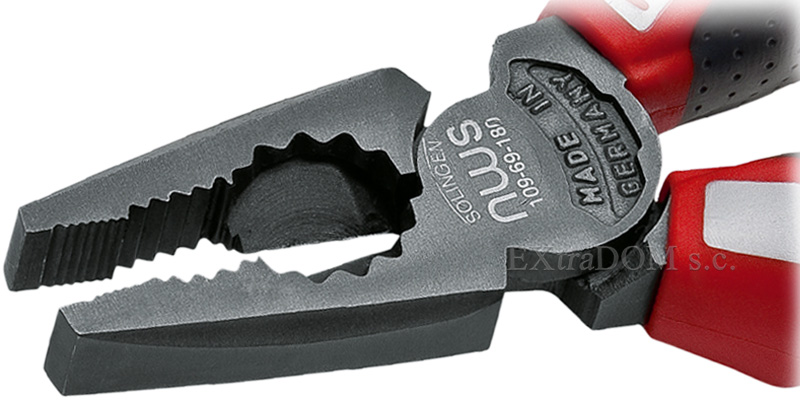 Slope
Slope
If you pick up combination pliers at the dealer, you will probably examine the most striking first: the two gripping jaws. Even as a layman, you can definitely judge based on a few criteria, whether the pliers are any good or not. For example the accuracy of fit: When pinched together, the two retaining surfaces must be exactly flush with each other (1). Even a few tenths of a millimeter of play indicate poor workmanship and stability of the pliers. The same applies to the milling of the coarse gripping teeth (2). Pay particular attention to this here, that these are precisely formed and all burrs are removed.
Some combination pliers offer a useful extra, which also offer somewhat more rounded gripping teeth at the level of the cutting edges (3). This allows hexagon nuts in particular to be gripped easily and fixed in inaccessible places- or turn loose.
Especially with the small combination pliers, the precision engineering pliers, is it important, that they are equipped with a spring or double spring (4). These springs open the pliers automatically, which is a great relief, especially for the more delicate work.
Material
When it comes to the surface treatment of the tool steel already mentioned, you have the choice between polished and blued, depending on the stress (for the occasional do-it-yourselfer) to the high-quality chrome-nickel coating (for the pro). Pay particular attention to this here, that the steel surfaces of the pliers are matt and therefore cannot dazzle.
The steel quality is of decisive importance for the sharpness of the blades as well as for the torsional rigidity of the holding surfaces. Some manufacturers mark this quality on the joint (Picture above). A C60 tool steel is tougher and harder than a C30 steel, the pliers are of course also more expensive overall. In good specimens, the cutting edges are additionally inductively hardened.
joint
The closer the swivel joint of the combination pliers is to the cutting edge and thus also to the holding surfaces, the better the leverage when gripping and the more force you can apply. Or the pliers can be shorter with the same power transmission and thus lighter and easier to handle. The pliers for these higher requirements therefore have a so-called joint eccentric (Picture above, right), which can be seen at first glance.
handle shell
As with almost all hand tools these days, the two-component handle is also standard for the combination pliers. The second, softer components on the outside of the handle ensure non-slip gripping. Be sure to pay attention to this when shaping the handle, that the handle scales have slip protection at the top end. These are the bulges on both sides, that prevent, that you can slip in the direction of the cutting edge due to the many ups and downs.
The electrician's pliers offer a special feature, which can be recognized by a yellow second handle component (Picture above). These handle scales protect up to 1000 V AC and 1500 V direct current, which is guaranteed by an individual piece test. The triangular VDE mark is printed on it.